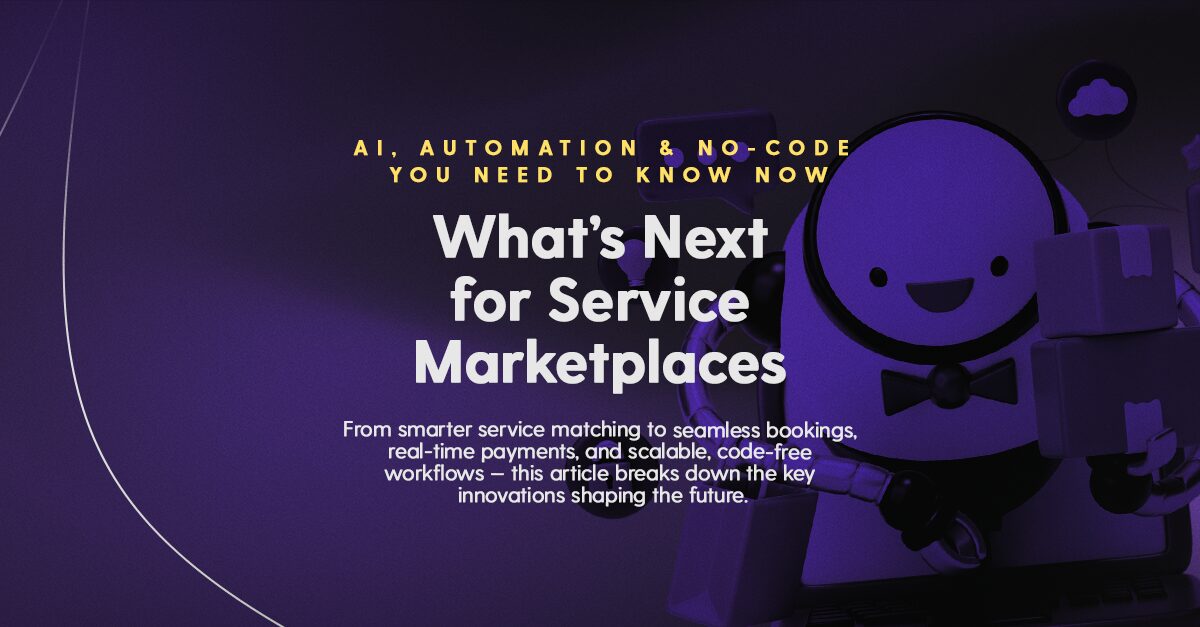We’ve entered a new era in how we build, grow, and scale service marketplaces. The playbooks of the past — manual operations, clunky interfaces, and one-size-fits-all platforms — are quickly being replaced by smarter, faster, and more flexible alternatives.
Welcome to Phase 4 of your marketplace journey: Advanced Insights & Thought Leadership. This is where you stop just keeping up — and start leading.
The world is shifting fast. Consumers want instant, personalized, and seamless experiences. Providers expect tools that are intuitive and efficient. And builders like you? You’re looking for speed, agility, and a way to compete without a 20-person engineering team.
That’s where the trifecta of AI, automation, and no-code innovation comes in. 77% of companies are either using or exploring AI in their operations, with 83% considering it a top priority in their business plans. These aren’t buzzwords anymore — they’re your competitive edge. And in this post, we’ll break down how they’re shaping the future of service marketplaces, how you can start leveraging them today, and why platforms like Dittofi are at the heart of this transformation.
Let’s take a look at what’s changing — and what you can do about it.
Why Smart Marketplaces Are Winning — And How You Can Build One
Let’s rewind for a second. A few years ago, launching a service marketplace meant building a basic directory. You’d list some providers, let users search and sort, and if you were lucky, they’d transact. But expectations have evolved.
Today’s users don’t just want access — they want intelligence. They want a platform that “gets” them. That anticipates what they need, guides them to the best match, and makes the whole process frictionless. In short, they want a smart marketplace.
And smart doesn’t mean flashy — it means functional, fast, and personalized.
Think of Amazon recommending exactly what you’re looking for. Or Spotify predicting your next favorite artist. Service marketplaces are catching up, and the future belongs to platforms that offer that same level of intelligence.
So what actually makes a marketplace smart?
It starts with being data-aware. Every click, search, booking, and review tells you something about your users. Smart marketplaces learn from this behavior and feed it back into the system — so the next user has a better experience.
It also means being adaptive. If supply is limited in a certain area, pricing adjusts dynamically. If a user has booked cleaning services twice in the last month, they get a membership offer or loyalty perk.
And perhaps most importantly, it’s about being predictive. Instead of showing users a huge list of providers and hoping they pick the right one, smart marketplaces use AI to show them the best ones — for their needs, preferences, location, and schedule.
The best part? You don’t need to reinvent the wheel to do this. You just need the right tools to plug into your platform.
4 Key Traits That Make a Marketplace Truly Smart (and Scalable)
The word “smart” gets thrown around a lot, but in the context of service marketplaces, it means a few specific things:
1. It’s Data-Driven
Every marketplace collects data — but smart marketplaces use it. They look at booking patterns, review scores, service categories, user profiles, and more to refine how the platform works. They use that data to improve matches, personalize experiences, and make decisions at scale.
2. It Offers Personalized User Journeys
Gone are the days of static listings. A smart marketplace dynamically adjusts what users see based on who they are, what they’ve done, and what they’re likely to need next. Whether it’s showing the top-rated cleaner who works weekday mornings or promoting a provider you’ve used before — it feels like the platform was made just for you.
3. It Runs on Automation
Manual workflows? Forget it. Smart marketplaces automate the boring stuff — like sending confirmations, updating availability, processing payments, or reminding users to leave a review. That means fewer errors, less admin, and a smoother user experience.
4. It Learns and Improves
The smartest platforms don’t just “work” — they get better over time. They use feedback loops to understand what’s working and what isn’t, and they adjust automatically. That’s what makes them scalable — not just in size, but in sophistication.
Smart marketplaces don’t require a team of data scientists or expensive tech. With modern platforms like Dittofi, you can start building intelligent features from day one — and scale them as you grow.
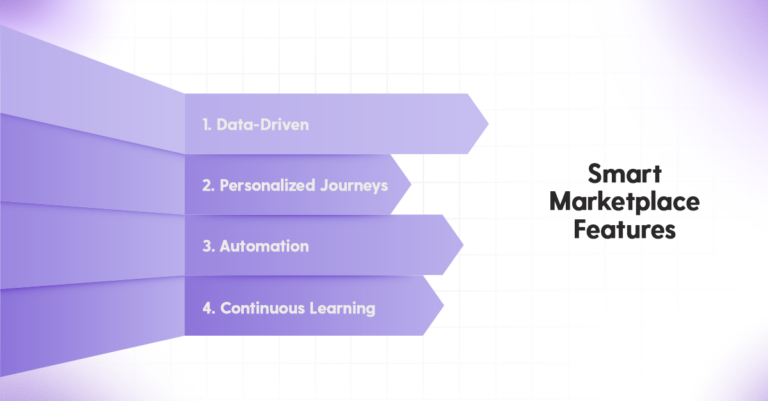
AI-Powered Matching: How Smart Marketplaces Are Replacing Filters Forever
Let’s be honest — filtering through providers by price, rating, and distance feels like online shopping circa 2010. And for users? It’s exhausting.
The real future of service marketplaces lies in AI-powered matching — platforms that do the thinking for users and present them with a tailored set of options that are actually useful. Think less “choose your own adventure,” more “we already know the best fit — here it is.”
AI changes everything. It doesn’t just match based on inputs; it understands context. It knows that someone searching for a massage therapist on a Sunday night probably wants in-home service. It knows that a parent booking a math tutor isn’t just looking for availability, but also experience with kids.
This isn’t a theory. Platforms like Uber, Upwork, and even Airbnb are already doing this. They’ve trained algorithms on user behavior and service outcomes to deliver smarter, faster, more relevant results.
And now, that kind of intelligence is accessible to everyone.
With tools like Dittofi, you can integrate AI models that do the heavy lifting:
- Analyze user preferences and recommend top providers
- Adjust recommendations based on past bookings or reviews
- Use real-time feedback to fine-tune future matches
It’s not about replacing human choice — it’s about enhancing it. Helping users find what they want without having to wade through pages of irrelevant results.
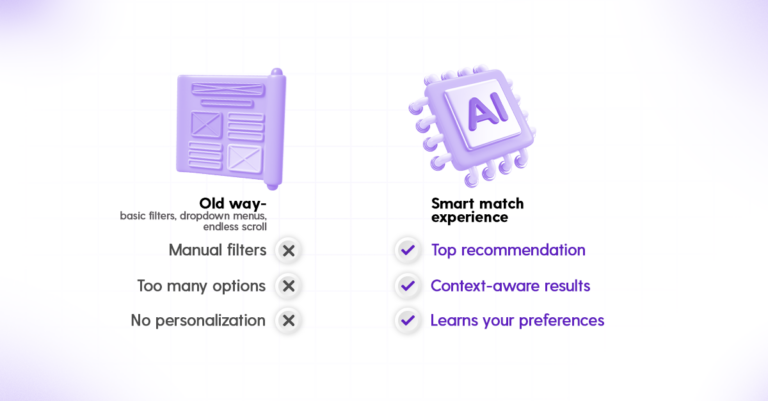
From Clicks to Conversions: How Algorithms Learn and Improve Your Match Rates
So how do these smart algorithms actually work?
It all starts with data. Every interaction a user has with your platform — clicking, scrolling, booking, reviewing — teaches your system something new. Over time, these signals add up. The more your platform learns, the better it gets at predicting what users want.
This is often done through:
- Collaborative filtering: suggesting services based on what similar users have booked.
- Content-based filtering: matching based on detailed provider profiles and user preferences.
- Behavioral learning: adapting in real time as user behavior shifts.
The result? A platform that gets sharper with every interaction. One that can suggest providers with near-psychic accuracy and make users feel like it was built just for them.
And with Dittofi’s open architecture and API integrations, you can start embedding AI into your workflows without having to build everything from scratch. Whether it’s plugging in a machine learning model or syncing with a third-party AI engine, the infrastructure is already there.
Why Automation Is the Only Way to Scale Bookings, Payments & Communication
If there’s one thing that separates platforms that survive from those that scale, it’s automation. Manual processes might feel manageable at first — but once you hit real traction, they become dead weight. Automating your core workflows isn’t just a time-saver, it’s what enables you to grow without breaking things.
Think about your current experience — how much time are you spending confirming bookings, processing payments, rescheduling appointments, or sending reminders?
Now imagine if all of that just happened.
That’s the magic of automation. And it doesn’t take a massive dev team anymore. With the right tools, you can design workflows visually, set triggers based on user behavior, and let your platform run key operations without constant human intervention.
Let’s break it down further.
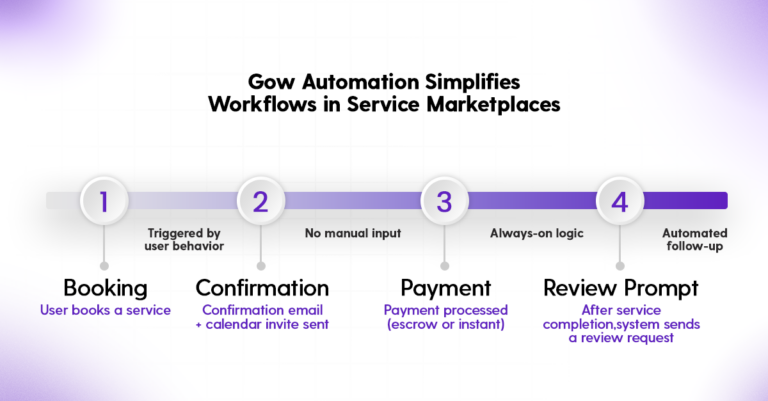
Booking Systems That Run Themselves
Manual booking systems work until they don’t. As soon as your user base grows or you start supporting providers in multiple locations or time zones, things can get chaotic fast.
Smart marketplaces use automated booking flows that:
- Check real-time availability
- Prevent double bookings
- Send instant confirmations
- Trigger reminders and follow-ups
This creates a smoother, more professional experience for both users and providers. Plus, fewer human touchpoints means fewer mistakes.
Dittofi’s integration capabilities allow you to connect with external scheduling tools, build your own booking logic, and even create dynamic calendars based on provider rules or user preferences.
Seamless Payments & Escrows
Payments are one of the most sensitive parts of any service marketplace. Trust is everything. And trust comes from transparency, reliability, and consistency.
With automation, you can streamline everything:
- Process payments instantly after bookings
- Set up escrow systems to hold funds until service is completed
- Offer subscription billing, milestone payments, or tip prompts
- Handle refunds and disputes through rule-based triggers
You’re not just making transactions easier — you’re making your platform more trustworthy. And today platforms let you build all this into your workflows visually, without having to write custom code or reinvent Stripe integrations every time.
Communication Automation That Feels Personal
Automation doesn’t mean generic. In fact, when done right, it actually feels more personal.
With intelligent workflows, you can:
- Send a warm, personalized welcome when someone signs up
- Remind users about upcoming appointments
- Follow up automatically asking for reviews or offering discounts
- Nurture users who haven’t booked in a while
The key is contextual messaging — sending the right message at the right time. The event-driven logic opportunities and built-in automation features let you craft entire communication journeys that adapt based on user actions.
It’s like having a marketing, support, and retention team working 24/7—without actually hiring one.
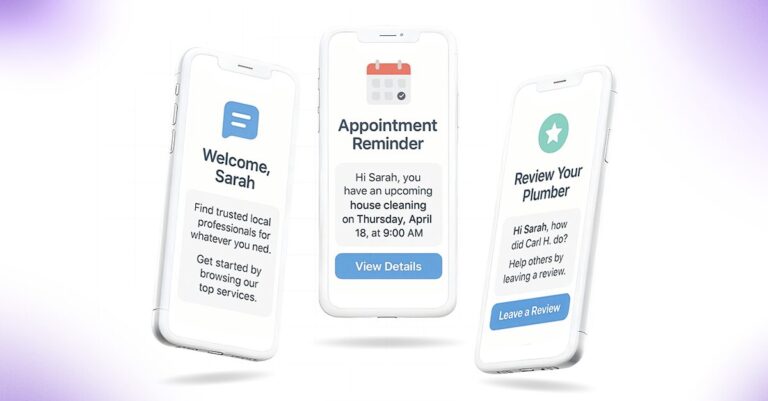
How No-Code Is Empowering Founders to Launch Marketplaces in Weeks
Once upon a time, launching a service marketplace meant hiring a team of developers, spending six or more months in development mode, and crossing your fingers that it would work. But that story is changing.
The no-code movement is transforming how marketplaces are built. It’s turning business owners, marketers, and product thinkers into creators — people who can build real, scalable platforms without needing to learn JavaScript or worry about server load.
No-code isn’t just about moving faster — it’s about moving smarter.
And if you’ve ever thought, “I know exactly what my users need, I just wish I could build it myself” — no-code with possible customizations is your ticket.
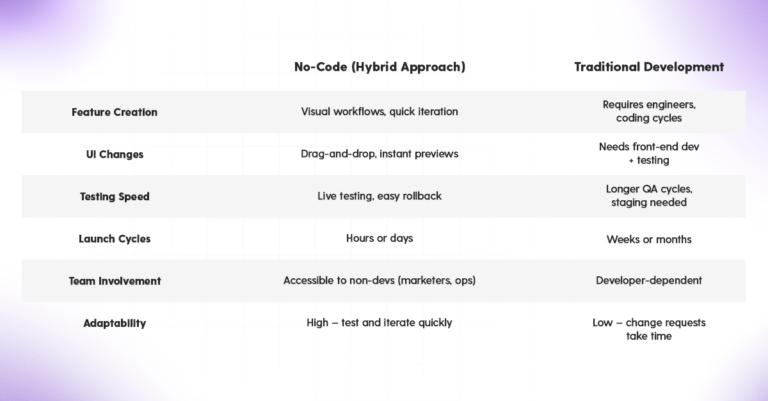
What No-Code Enables That Code Slows Down
Let’s be real: traditional, custom development has its place. It’s powerful, flexible, and can take you anywhere… eventually. But for most marketplace founders — especially in those fast-moving early and growth stages — waiting weeks (or months) for every feature, fix, or update? It’s just not sustainable.
You come up with a brilliant new idea after talking to users. You sketch out a feature tweak that could boost conversions. You notice a friction point that’s hurting signups. And then? You wait. For a dev handoff. For a sprint slot. For the QA cycle. For it to maybe get deployed — if nothing else breaks first.
That kind of bottleneck is fine if you’re running a billion-dollar engineering department at Google. But for you? You need speed. Agility. The power to move.
That’s where no-code comes in — and why it’s so much more than a buzzword.
With a hybrid no-code platform like Dittofi, you get to build real, working interfaces and workflows — fast. You’re not just dragging and dropping buttons on a page; you’re crafting entire user experiences, defining logic, and deploying updates in real-time.
Here’s what no-code unlocks for your team:
- You can build UIs that users love, tweak them instantly, and ship them without waiting for a dev.
- You can test new features live — A/B style or even just soft-launch—to see what works and iterate quickly.
- You can deploy changes in hours, not weeks, and roll them back just as easily if something doesn’t land.
- You can empower your entire team to build — marketers, designers, ops folks — without them needing to know a single line of code.
And no, this doesn’t mean developers are obsolete. Quite the opposite. Developers still play a crucial role in scaling, security, and advanced integrations. But with no-code, you’re not relying on them for every. single. thing.
It’s not about cutting corners. It’s about cutting friction.
In today’s fast-paced marketplace landscape, adaptability is everything. The platforms that win won’t be the ones with the biggest budgets—they’ll be the ones who can move the fastest, listen to their users, and make bold, strategic changes without weeks of red tape.
No-code isn’t a shortcut. It’s your competitive edge.
The Triple Threat: How AI, Automation & No-Code Supercharge Marketplace Growth
Now let’s connect the dots.
AI on its own is powerful. Automation is efficient. No-code/hybrid approach makes everything faster and more accessible. But when you combine all three? That’s when things really start to compound.
Imagine a user lands on your platform. AI instantly recommends the best provider for them based on intent, location, and service history. They book the service in seconds. The system automatically confirms the booking, schedules it, and processes the payment. Meanwhile, Dittofi is tracking behavior in the background, preparing personalized follow-ups and loyalty offers for the next visit.
All this happens without a single manual touchpoint.
That’s not just growth — that’s scalable, intelligent growth. Growth that builds on itself. Growth that allows your team to stay lean while your user base expands. Growth that feels human to your customers, even though it’s largely powered by systems.
This compound effect is what sets the next generation of service marketplaces apart. It’s the difference between platforms that hustle and those that hum.
And the beauty of it all? You don’t need custom infrastructure to get there. You just need a platform that brings it all together — like Dittofi.
AI + Automation + No-Code: Not a Trend — Your Marketplace Survival Plan
It’s easy to look at AI, automation, and no-code as just “what’s hot right now.” But here’s the truth: these aren’t trends. They’re foundational shifts in how digital businesses are built and scaled.
The platforms that will lead the next decade of service innovation aren’t just adopting these tools — they’re building around them.
Here’s why:
- AI isn’t just a feature — it’s how modern users expect digital products to behave. They want platforms that anticipate their needs, not just react to their clicks.
- Automation isn’t just a time-saver — it’s what allows small teams to deliver big experiences. It’s what makes you feel like a 20-person company when you’re really a team of 3.
- No-code isn’t a shortcut — it’s a strategic lever. It empowers non-technical founders, marketers, and ops managers to build, test, and grow without always leaning on dev resources.
This isn’t about riding a wave. It’s about future-proofing your platform — so you’re not scrambling to keep up in a few years. Approximately 34% of all business-related tasks are currently automated to improve workflows, with 94% of businesses expressing a preference for unified platforms that connect applications and automate workflows.
Smart founders are already moving in this direction. The question isn’t “if” you’ll need these tools — it’s how soon you can start integrating them.
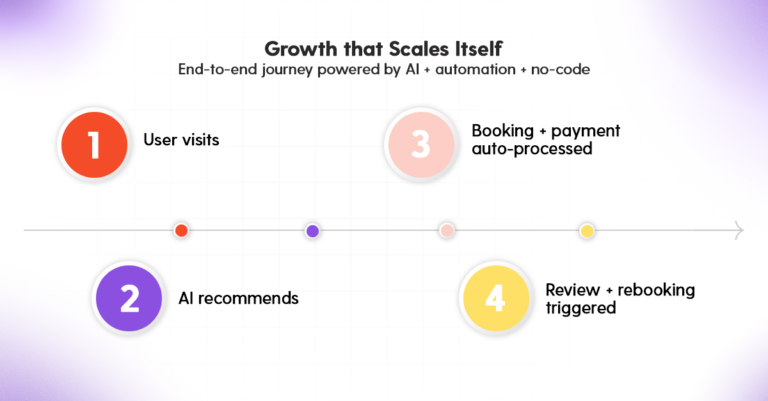
How Dittofi Future-Proofs Service Marketplaces With Scalable Tech
There are plenty of tools out there, each promising to handle one slice of your platform — whether it’s landing pages, payments, automation, or AI matching.
But Dittofi is different because it’s designed as a full ecosystem. It doesn’t just plug gaps — it enables strategy.
Here’s why Dittofi is built for the future:
1. It’s Full-Stack, Not Fragmented
You don’t need to cobble together five platforms to get what you need. With Dittofi, your frontend, backend, workflows, logic, and integrations all live in one seamless place.
2. It’s Open and Extensible
Want to add AI matching? Use your own model or plug in third-party tools. Need a custom CRM flow? You can build it right in. Dittofi gives you the flexibility to adapt without ripping things apart.
3. It’s Built to Scale
Whether you’re launching your MVP or managing thousands of users, Dittofi grows with you. Its architecture is built for high performance, secure transactions, and dynamic data handling.
4. It’s Designed for Builders
Whether you’re a solo founder, a growth marketer, or leading a small product team, Dittofi puts control in your hands. You don’t need to be technical — you just need vision.
And perhaps most importantly, Dittofi isn’t just about today — it’s about what’s next. As new tools emerge and user expectations evolve, Dittofi evolves with them.
So if you’re looking to build something that’s not just modern — but enduring — this is where you start.
Next Steps: Lead the Future of Marketplaces — Not Just Follow It
The world of service marketplaces is changing fast. Users expect intelligent, seamless experiences. Teams need tools that scale without drama. And founders are looking for smarter ways to build without spending a fortune or sacrificing quality.
AI, automation, and no-code aren’t just nice-to-have — they’re the building blocks of the next era of digital platforms.
Whether you’re just launching or looking to evolve an existing platform, the opportunity is massive — but only if you’re prepared for it.
And that’s what Phase 4 is all about: thinking ahead, building smarter, and stepping into the role of thought leader in your market — not just another player.
You don’t need to guess your way through it. You don’t need a dev team in the wings.
You just need the right foundation.
Be ahead of the curve — build smarter with Dittofi.
Your marketplace deserves to lead — not lag. With Dittofi, you’re not just building faster. You’re building smarter, stronger, and more ready for what’s next. Ready to shape the future?

